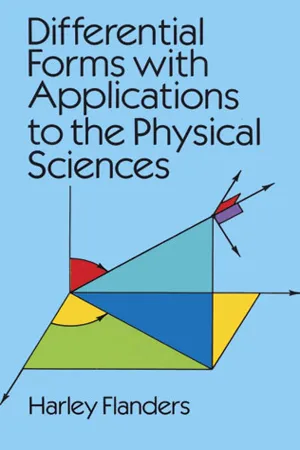
- 240 pages
- English
- ePUB (mobile friendly)
- Available on iOS & Android
Differential Forms with Applications to the Physical Sciences
About This Book
"To the reader who wishes to obtain a bird's-eye view of the theory of differential forms with applications to other branches of pure mathematics, applied mathematic and physics, I can recommend no better book." — T. J. Willmore, London Mathematical Society Journal.
This excellent text introduces the use of exterior differential forms as a powerful tool in the analysis of a variety of mathematical problems in the physical and engineering sciences. Requiring familiarity with several variable calculus and some knowledge of linear algebra and set theory, it is directed primarily to engineers and physical scientists, but it has also been used successfully to introduce modern differential geometry to students in mathematics.
Chapter I introduces exterior differential forms and their comparisons with tensors. The next three chapters take up exterior algebra, the exterior derivative and their applications. Chapter V discusses manifolds and integration, and Chapter VI covers applications in Euclidean space. The last three chapters explore applications to differential equations, differential geometry, and group theory.
"The book is very readable, indeed, enjoyable — and, although addressed to engineers and scientists, should be not at all inaccessible to or inappropriate for... first year graduate students and bright undergraduates." — F. E. J. Linton, Wesleyan University, American Mathematical Monthly.
Frequently asked questions
Information
VIII
Applications to Differential Geometry
8.1. Surfaces (Continued)















Table of contents
- Title Page
- Copyright Page
- Dedication
- Foreword
- Preface to the Dover Edition
- Preface to the First Edition
- Table of Contents
- I - Introduction
- II - Exterior Algebra
- III - The Exterior Derivative
- IV - Applications
- V - Manifolds and Integration
- VI - Applications in Euclidean Space
- VII - Applications to Differential Equations
- VIII - Applications to Differential Geometry
- IX - Applications to Group Theory
- X - Applications to Physics
- Bibliography
- Glossary of Notation
- Index